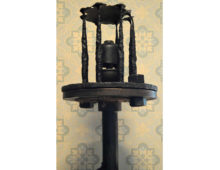Tagged with French Revolution
Resource : Red Flag
Today the red flag has, predominantly, become a symbol of socialism and communism. Its European origins date back to the Middle Ages, when a red streamer flying from the mast of a warship signalled a willingness to fight to the death, with no surrender. But its radical political roots lie firmly in the Age of Revolution.
Resource : French Guillotine Blade
The guillotine is best known as a method of executing those condemned to death during the French Revolution. Although it delivered a grisly end – by slicing off its victim’s head, death by guillotine was quick and humane. During the ‘Reign of Terror’ in France, as many as 40,000 people were executed by ‘Madame Guillotine’.
Resource : Phrygian ‘liberty’ cap
Red Phrygian or ‘liberty’ caps were long associated with the theme of liberty in European and colonial cultures. They were used as icons during the American Revolution and worn during the French Revolution in the late 1700s and came to symbolise allegiance to the republican cause. Along with the red, white and blue cockade, pinned to these and other hats, they became a lasting symbol of revolutionary France.
Resource : Napoleon’s Hat
This hat was worn by the French Emperor Napoleon when he commanded the French Army at the Battle of Waterloo. The hat was a vital part of the image of a hard-working, down-to-earth leader that Napoleon tried to create. His profile was instantly recognisable to French soldiers, most of whom were devoted to him. The red, white and blue cockade, pinned to the hat, is a symbol of the French Revolution.
Resource : Laffayette orange peel quilt
Quilting has a long history in North America, dating back to the early colonial settlers of the 1600s and bringing together different ethnic and cultural traditions. As well as their practical use for warmth, they were made – often communally – to mark important family occasions such as weddings and births. As quilt-making developed from a practical necessity into skilled folk artistry, different patterns and symbols emerged carrying different meanings. This classic ‘orange peel’ design is said to have been influenced by Lafayette.
Resource : Cosette Sweeping
Cosette, is a central character in Victor Hugo’s novel, Les Misérables, an epic story with revolution at its very heart. First published in 1862, Hugo’s tale is one of the longest novels in history. It is widely considered to be a masterpiece and has been adapted countless times for stage and screen.
Resource : The Pussyhat
The Pussyhat project is a social movement focused on raising awareness about women’s issues and advancing human rights. Propelled by social media – a revolution in communications – the pussyhat has rapidly become an international symbol for women’s rights, political resistance and collective action.
Resource : The Cult of the Supreme Being
The French revolution was a period of major uprising and upheaval for France, between 1789 and 1799, when people fought for an end to the power and privilege held by the monarchy, aristocracy and Catholic Church, over ordinary people. Maximilien Robespierre (1758 – 1794) was a powerful and ruthless figure in the revolution. He introduced the Cult of the Supreme Being as a new state religion, as part of his vision for revolutionary France.
Resource : Olympe de Gouges
Olympe de Gouges was a radical feminist and one of the first people to fight for equal rights for women. She campaigned against violence and oppression and spoke out against slavery. But despite her pacifist views, her radical ideas eventually led to her death, at the guillotine, in revolutionary France.
Resource : Hannah More (1745 – 1833)
Hannah More (1745-1833) was a poet, playwright, anti-slavery campaigner and one of the most influential female philanthropists of the Age of Revolution. Seen by some as an early feminist, and others as an anti-feminist, she remains a controversial figure today.


